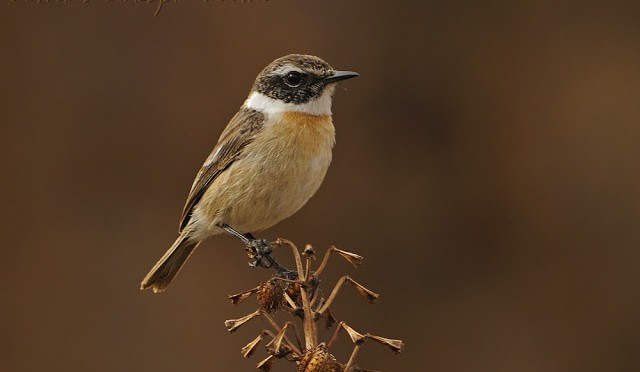Photo: © 2012 Thomas Crespo
Definitely on our island of Fuerteventura we have an extensive bird life, but one of these species is also endemic to this island of the Canaries: the Stonechat.
This unique bird of “majorera” bird life also has the distinction of being the only species that, being unique to the Canary Islands, is only found in one of the islands; for this reason, “majoreros” should be proud and take special care in preserving it. Until the early twentieth century Stonechat also inhabited the islands of Alegranza and Montaña Clara, north of Lanzarote, Canary Islands stonechat murielae, but currently it is only found in Fuerteventura, Canary Islands stonechat dacotiae. The rest of birds which are endemic to the Canary Islands, like the two pigeons laurel, the canary fly and blue finch, are distributed in at least two of the islands.
The Stonechat Canary is a passerine Muscicapidae bird, which inhabits dry and rocky lands. It possibly derived from the Stonechat species and evolved because of its isolation on the island, where it would arrive about two million years ago in the Pleistocene.
It is a small bird, whose body resembles that of a robin but more stylized. It has contrasting brown colours, with blackish head and back and white striped wings. It has a circular white stripe that reaches the rear part of itseyes. The sides of tits neck are also white (for male), like its belly. The chest is orangish. The female has duller colors and streaked brown head.
 Regarding its habitat, it’s a very faithful species to its territory, remaining all its lifetime in the same place, unless exceptional events occur, such as a divorce from its partner, which is rather unusual as they are often very faithful to their partners.
Regarding its habitat, it’s a very faithful species to its territory, remaining all its lifetime in the same place, unless exceptional events occur, such as a divorce from its partner, which is rather unusual as they are often very faithful to their partners.
It is found in rocky lands and gorges with vegetation such as palm groves and small areas with gorse, though sometimes it can visit more open and arid areas, like”el malpaís”.
To get their food and their chicks’, they usually place on perches at the top of bushes, from where they have a privileged view to pounce on small invertebrates, and these perches are true models for amateur bird photographers.
They usually lay their eggs twice per year, 4-5 eggs each time, which they incube for 13 days.
This species is listed as endangered and ther are currently about 1300-1700 adult specimens, whose number is gradually dicreasing. The main causes of this extinction is the strong tourism development which has suffered its habitat in recent decades, due to the massive construction of homes, hotels, golf courses … which have fragmented and reduced its territory. On the other hand, the uncontrolled overgrazing of wild goats also affects them and the introduction of species like wild cats and black rats, which prey on their chicks.
Since 1999 there is a preservation plan for this species and, due to its high reproductive rate the difficulty of their survival might be overcome if we look after their habitat.
FuerteCharter Team.
